Wireless Exposure
I was surveying at a school a few years ago with some special test equipment to assist me in designing a wireless network. I wandered through the staff office and was asked what I was doing. A teacher who was under a WiFi Access Point (AP) asked, “Can these things (pointing to the AP) give me cancer?” I told her it is highly unlikely. She went on to tell me that she had just come out of remission for breast cancer so that put some context to her question.
Recently a worried mother rang me about the wifi coverage at her school and what damage could it do to her children. She was a doctor and had trouble finding any research.
In both cases, they had genuine concern and I went through my explanation of things as an engineer (someone who used to design radios and radio systems). I get asked these sorts of questions quite frequently and I have seen some very poor and often misguided reporting on the topic especially in mainstream media.
I thought I would share what I know as a wireless system designer, providing some facts to hopefully bring perspective and shed light on this subject. I aim to provide straight forward explanations to assist those of my audience that are less technically minded.
What is Radio?
A radio is the transfer or transmission of electromagnetic radiation within a limited spectrum. This is an alternating electrical potential and magnetic field strength. Electromagnetic radiation is a combination of magnetic and electrical waves. Light is a very high frequency of electromagnetic radiation.
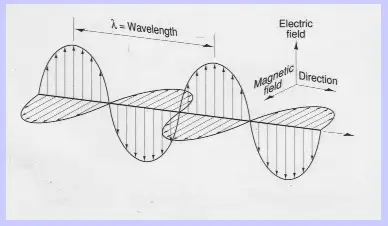
When we launch a radio signal and vary its amplitude or frequency we can transmit information like music (analog information) or data (digital or discrete).
To launch or propagate a radio wave we have to present an alternating voltage and current to a radiating element, or antenna. The antennas physical dimensions or attributes are tuned to the frequency of that alternating voltage and current. A receiving (also tuned) antenna picks up that variating potential magnetic and electrical fields to create a voltage and current.
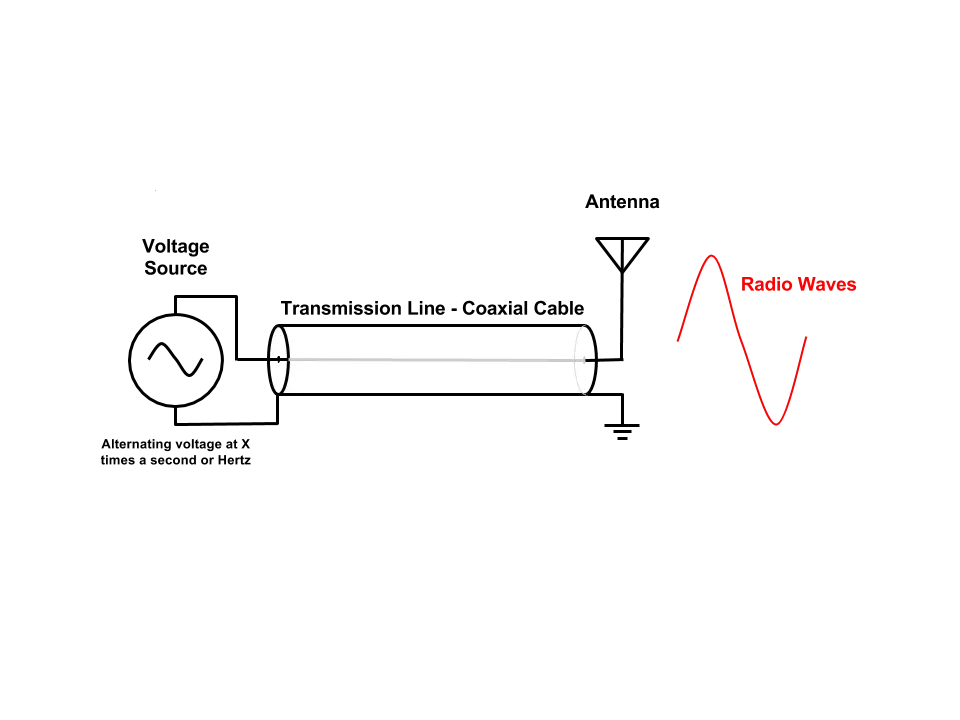
When a radio signal is transmitted, it goes everywhere. Antennas sometimes can direct energy more in one direction than others. Many antennas, like a CB radio antenna operate like lantern, a source of light that sends light everywhere equally. Some are like a flashlight and direct energy in one direction (telecommunications dish for example).
If we have a source of radio energy connected to an antenna that behaves like a lantern, the energy is distributed everywhere like the light. So, if you walked around the antenna at a set distance the receive signal strength will be the same.
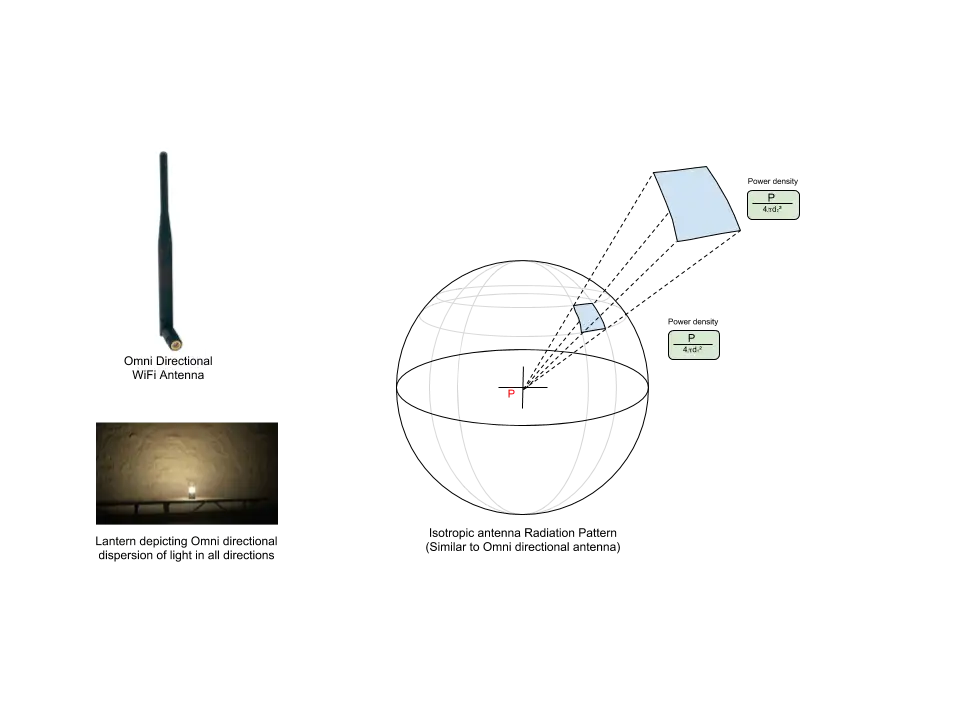 If you walked around the antenna that works like a flashlight then as you walked around that antenna at the same fixed distance, for most of it you will pick up very little but for a small part of the walk you will receive all the radiated energy. So, the flashlight type antenna delivers the same energy but in a smaller area. We would deem this sort of antenna a high gain antenna.
If you walked around the antenna that works like a flashlight then as you walked around that antenna at the same fixed distance, for most of it you will pick up very little but for a small part of the walk you will receive all the radiated energy. So, the flashlight type antenna delivers the same energy but in a smaller area. We would deem this sort of antenna a high gain antenna.
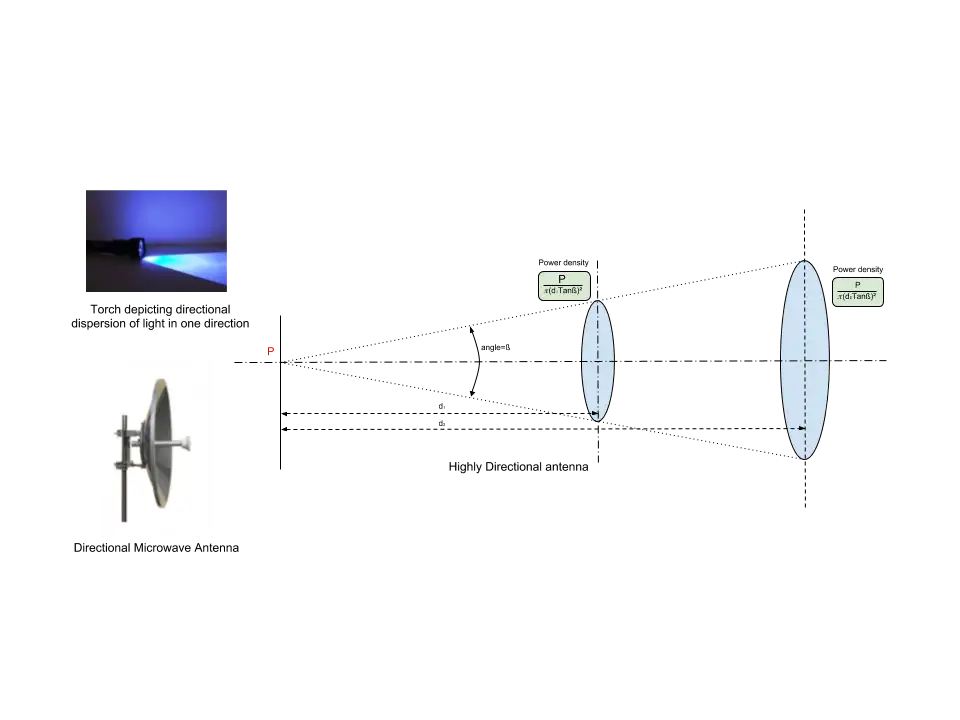
When a radio signal is transmitted, it loses its strength based on the distribution of energy in three dimensions. At any distance, we can calculate the energy density and is presented at watts per square meter. Sunlight is about 1000W/M2 to give some perspective although it is a very wide spectrum of frequencies. Radio is typically a discrete frequency, essentially meaning it typically transfers at a single frequency.
Most WiFi Access Points and computers have antennas that operate like a lantern. So, if you are close to the antenna you will receive more of that energy than if you are far away. It diminishes at rate that is related to the squaring of the distance. So, if you measure the energy level at 1 meter and then at 2 meters it will be reduced by 4 times.
WiFi System and Duty Cycle
A WiFi system is made up from a computer (PC), Access Point (AP), and a network. They communicate by sending packets of data to and fro. When either sends a packet, the data is transformed into many discrete “tones”, modulated, then amplified and fed to the antenna. So, if there is no data to send then no radio signals are generated.
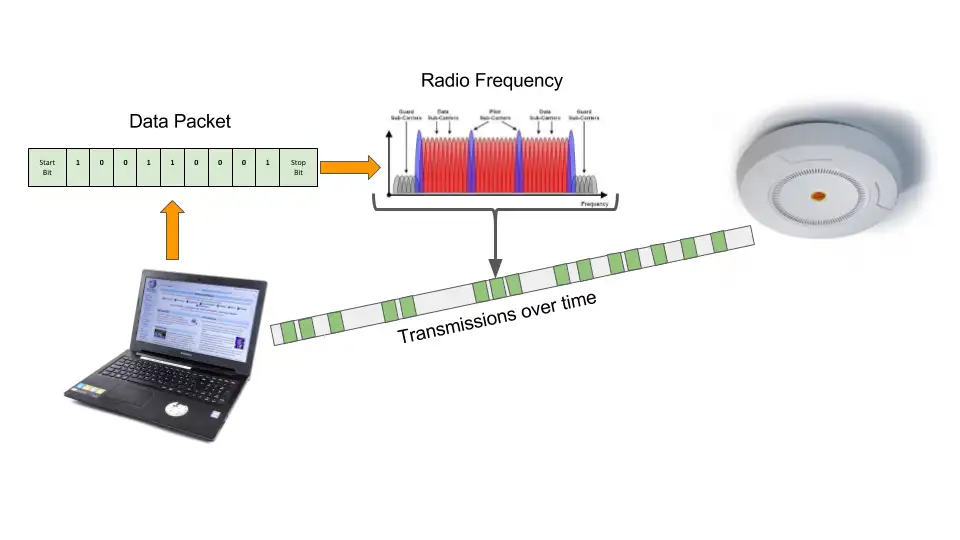
There are packets that are sent between the AP and PC so that they can manage their environment. For example, an AP will send beacon packets to identify itself and its capabilities. These management packets consume very little time and bandwidth compared to the main data stream which could be a movie or web site, but are important for keeping order. So, an AP or PC are not continuously transmitting.
When the AP and PC communicate, they share the same radio channels. So, only one can transmit at a time. So, each will listen before starting to transmit. If you are downloading a file or watching a movie, most of the data is going from the AP to the PC. If you are uploading a picture to Facebook most of the data is going from PC to AP.
When the AP connects to many PC’s in the area they share the same channel also. So all devices wait for a clear channel before transmitting. All this happens very quickly so for heavy users, such as 30 students in a classroom, we can have a single AP serve their needs. We can monitor the use of the channel and how much it is consumed and refer to it as Duty Cycle.
So, while the AP and PC’s are connected and “chatting” they only radiate Radio Frequency (RF) energy when they transmit. We know that when a WiFi system is running at 70% capacity (Duty Cycle) it has reached its peak capacity. So, in this case if we consider the transmit power and density they are only present for 70% of the time.
Exposure to RF energy
I have read lots of reports and research into what happens to humans when they are exposed to RF energy. A lot of people think of microwaving their food when they think of RF energy exposure but there are many sources.
There are two types of RF energy, non-ionising and ionising. Ionising radiation is RF energy that can eject an electron from atoms. Ionizing RF energy is very high and occurs typically at frequencies at or above ultraviolet light (includes X-rays etc). Wifi signals and most other radio systems operate far below these frequencies. Ionising radiation from normal RF frequencies can occur but that would be close physically to a very high power transmitter or something like a nuclear explosion in the Ionosphere for example.
Non-Ionising RF energy occurs at a low frequency. Wifi RF energy is both low power and low frequency therefore it is certainly non-ionizing.
In the 70 and 80’s Bell Laboratories in the US conducted some tests on RF energy absorption. They used pigs for their tests. So, whilst we absorb all forms of RF energy it turns out we absorb higher rates at certain frequencies. They found that we absorb more in the frequency range of 30-300Mhz, however we still absorb RF energy at other frequencies. They have determined that the maximum a human can sustain is 4 watts per KG of body weight.
Current medical and engineering research tend to revolve around the topics of heating and cancer risk. I have read various medical articles surrounding the topic of radiation therapy. In general, the research links RF exposure to the likelihood of cancer. It shows that X joules of energy are linked to the probability of getting cancer, however I have not seen any specific values and formulas in any research especially in in terms of more or less than something else, like sunlight.
The RF energy from Wifi is far less than standing out in the sunlight, but there may still be a low probability. Some people think that if there is a chance then it must be the cause, but this isn’t how probability works.
WiFi RF Energy and Standards
To understand the level of exposure I have compared the RF energy from a Wifi Access Point (AP), A commercial laptop and a standard tablet, at distances you would typically be exposed, in the table below:
10 Meters from a standard commercial grade Access Point
0.5 Meter from a standard commercial laptop
0.5 Meter from a standard tablet
Transmits at +22dBm (input to antenna) or +25dBi (EIRP) Transmits at +20dBm (input to antenna) or +23dBi(EIRP) Transmits at +10dBm (input to antenna) or +13dBi(EIRP) Represents 316mW (EIRP) at the source. Represents 200mW (EIRP) at the source Represents 20mW (EIRP) at the source Represents .025uW/cm2 at the 10M point Represents 6.36uW/cm2 Represents .636uW/cm2
The Australian Standard from AMCA (an FCC in the US) called for maximum exposure in the following ways (from 2GHz to 300GHz): (A) Limits for Occupational/Controlled Exposure: 5mW/cm2. (5000uW/cm2) (B) Limits for General Population/Uncontrolled Exposure: 1mW/cm2 (1000uW/cm2)
We work with (B) above and as you can see the signal strengths in the above examples are at worst 1000 times less. You can see however that the exposure from the laptop or tablet is much more significant than the AP.
Conclusions
When myself or my staff, walk around a classroom or an office with our measurement instruments we can read signal strengths. We typically engineer the signal strength to be better than -62dBm and that means we are typically 5-10M from an AP. In most of our clients sites the signal strength typically varies from -50dBm to -70dBm with the average of a good wireless system sitting around -60dBm.
When we analyse the signal strength of signals from mobile phone towers in the same space we typically get similar signal strength readings (-60dBm to -80dBm). So, if we disregard mobile handsets and wifi connected laptops, then turned off all the WiFi AP’s, we are still exposed to the mobile phone network at similar signal strength.
Whilst the exact risk of exposure is unknown, with the current accepted standards, the levels of exposure and energy absorbed from Wifi AP’s are extremely low, especially in comparison to other common sources (per calculations above). This essentially means that if you were going to get cancer from exposure to RF energy it would be much more likely through exposure to your mobile device, computer or even the Sun, then it would be through a Wifi AP.
